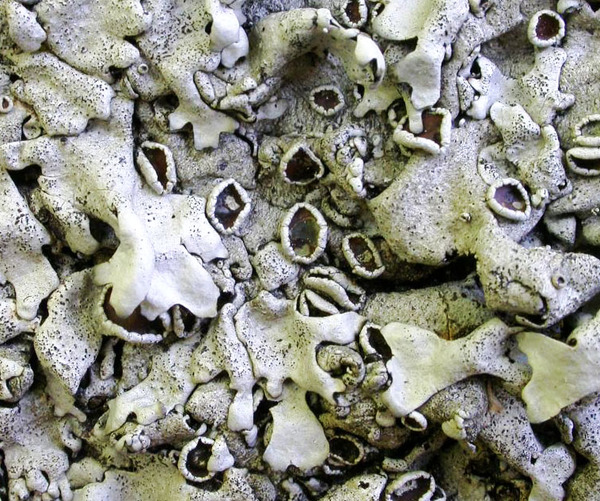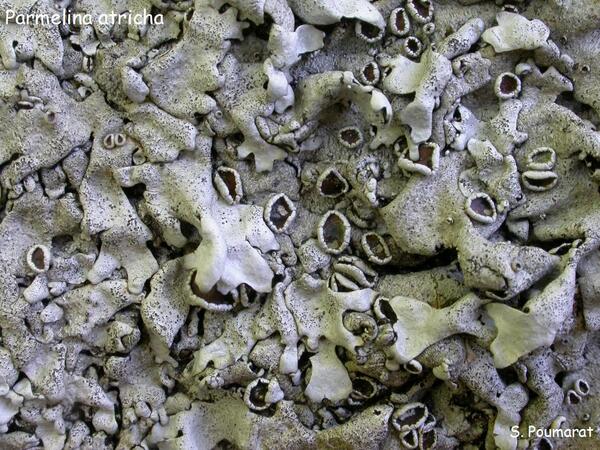Parmelina atricha (Nyl.) P. Clerc
in Clerc & Truong, Sauteria, 15: 185, 2008. Basionym: Parmelia atricha Nyl. - Bull. Soc. linn. Normandie, sér. 2, 6: 271, 1872.
Synonyms: Parmelia quercina f. saxicola (Körb.) Zahlbr.; Parmelia quercina var. convoluta (Schaer.) Zahlbr.
Distribution: N - TAA (B 60 0197479 and B 60 0197480, det H. Sipman), Lomb (Anzi, Lich. Lang. 26: Clerc & Truong 2008).
Description: Thallus foliose, heteromerous, dorsiventral, loosely adnate, forming 3-10 cm wide rosettes, the central parts becoming more or less panniform, being covered by numerous overlapping lobules. Peripheral lobes 2-3 mm wide, dichotomously or irregularly branched, usually deeply incised, at first contiguous, but soon overlapping, flat to slightly concave, the tips more or less rotund and crenate, epruinose, with short, black marginal cilia most frequent along the characteristically rounded axils; central lobules 1-2 mm wide, irregularly or dichotomously branched, epruinose, flat to distinctly convex. Upper surface pale mineral grey, emaculate, smooth, often more or less shiny; lower surface black in central parts, brownish in marginal parts, shiny, with dense, 0.8-2 mm long, thin, simple, black and shiny rhizines. Upper cortex of tightly packed, anticlinally oriented hyphae, with a pored epicortex, the cell walls with isolichenan; medulla white; algal layer continuous; lower cortex paraplectenchymatous, with rounded and thick-walled cells. Apothecia common, lecanorine, 2-3(-5) mm across, with a red-brown disc and a thick thalline margin with distinctly wrinkled lower surface bearing no or few rhizines. Epithecium brownish; hymenium and hypothecium colourless. Asci 8-spored, clavate, Lecanora-type. Ascospores 1-celled, hyaline, ellipsoid, 8-11 x 5-7 μm. Pycnidia black, usually numerous. Conidia bacilliform, straight, 5-7 x c. 1 μm. Photobiont chlorococcoid. Spot tests: upper cortex K+ yellow, C-, KC-, P-; medulla K-, C+ red, KC+ red, P-, UV-. Chemistry: upper cortex with atranorin; medulla with lecanoric acid (major), and gyrophoric acid (minor).Note: a saxicolous species described from the Pyrenees, so far known from the eastern Pyrenees, southern France, Northern Italy and southern Switzerland, with a mainly submediterranean-montane distribution (see Clerc & Truong 2008). It grows on siliceous rocks in more or less exposed, dry areas, with optimum in the montane belt.
Growth form: Foliose, broad lobed
Substrata: rocks
Photobiont: green algae other than Trentepohlia
Reproductive strategy: mainly sexual
Commonnes-rarity: (info)
Alpine belt: absent
Subalpine belt: absent
Oromediterranean belt: absent
Montane belt: extremely rare
Submediterranean belt: extremely rare
Padanian area: absent
Humid submediterranean belt: absent
Humid mediterranean belt: absent
Dry mediterranean belt: absent

Predictive model
Growth form: Foliose, broad lobed
Substrata: rocks
Photobiont: green algae other than Trentepohlia
Reproductive strategy: mainly sexual
Commonnes-rarity: (info)
Alpine belt: absent
Subalpine belt: absent
Oromediterranean belt: absent
Montane belt: extremely rare
Submediterranean belt: extremely rare
Padanian area: absent
Humid submediterranean belt: absent
Humid mediterranean belt: absent
Dry mediterranean belt: absent

Predictive model
 Index Fungorum
Index Fungorum
 GBIF
GBIF



